Old NCERT Summary (Satish Chandra): Northern India | History for UPSC CSE PDF Download
| Table of contents |

|
| Introduction |

|
| The Struggle for Domination in North India: The Palas |

|
| Pratiharas |

|
| Rashtrakutas |

|
| Political Ideas and Organization |

|
Introduction
After Harsha’s empire declined in the 7th century, several large states emerged in northern India, the Deccan, and south India. Unlike the Gupta and Harsha empires, which controlled the Ganga valley and used its resources to dominate Gujarat and its trade, no northern kingdom fully united the Ganga valley after Harsha. In the south, the Cholas controlled the Krishna, Godavari, and Kaveri deltas, forming the basis of their power.
Between 750 and 1000 AD, three major empires arose: the Pala empire in eastern India, the Pratihara empire in western India and the upper Gangetic valley, and the Rashtrakuta empire in the Deccan. These empires often clashed but provided stability, extended agriculture, built ponds and canals, and supported arts and temples. The Rashtrakuta empire, the strongest and longest-lasting, acted as a bridge between north and south India in trade and culture.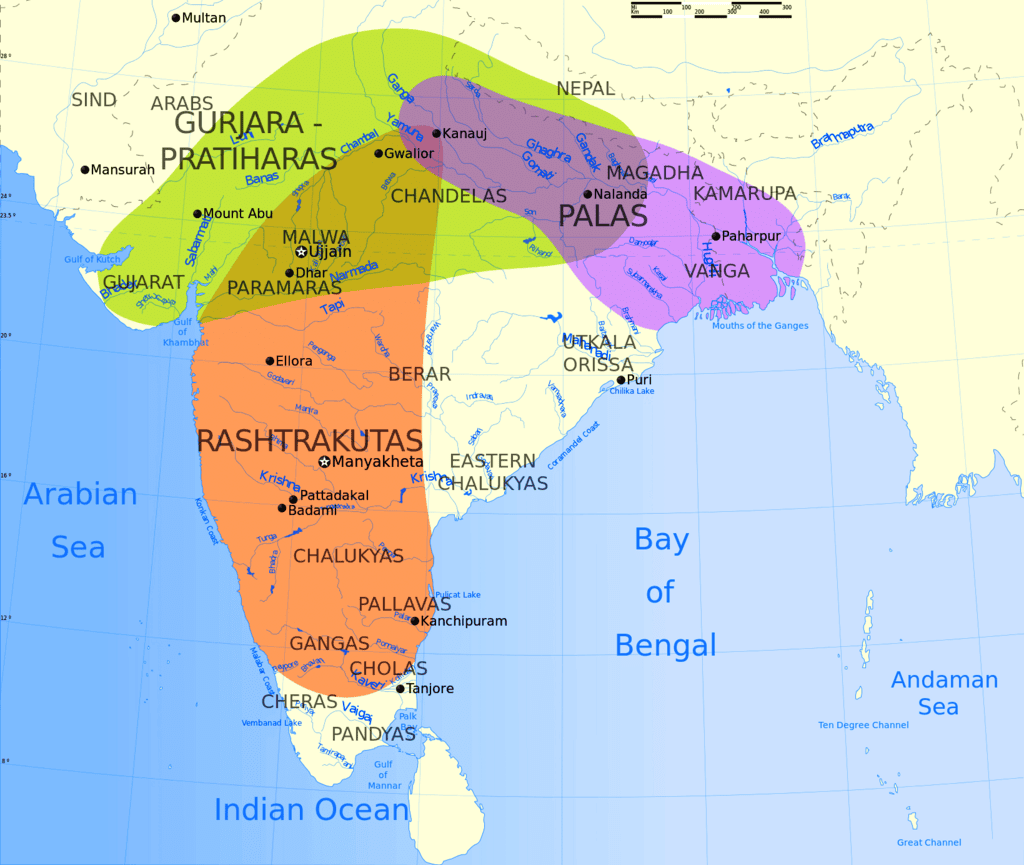 Age of Three Empires
Age of Three Empires
Northern India
The Medieval Indian History period lies between the 8th and the 18th century A.D. Ancient Indian history came to an end with the rule of Harsha and Pulakesin II. The medieval period can be divided into two stages:
- Early medieval period: 8th - 12th century A.D.
- Later Medieval period: 12th-18th century.
Tripartite Struggle for Kanauj
(a) The Tripartite Struggle for Kanauj was between the Pratiharas of Central India, the Palas of Bengal and the Rashtrakutas from the Deccan.
(b) As all these three dynasties wanted to establish their supremacy over Kanauj and the fertile Gangetic Valley.
(c) The Tripartite Struggle lasted for 200 years and weakened all of them which enabled the Turks to overthrow them.
The Struggle for Domination in North India: The Palas
The Pala Empire emerged as a significant power in northern India following the decline of Harsha’s empire, marking a period of political instability in the region. This dynasty, originating in the 8th century, played a crucial role in shaping the history of eastern India through its military campaigns, cultural patronage, and trade connections.
1. Rulers of Pala Empire
- Gopala (765-769 A.D.)
(a) Gopala, the founder of the Pala Dynasty, played a crucial role in restoring order in Northern and Eastern India during a time of chaos.
(b) He expanded the Pala dynasty and extended his power over Magadha. - Dharmapala (769-815 A.D.)
(a) He is the son of Gopala and succeeded his father,
(b) He brought Bengal, Bihar, and Kanauj under his control,
(c) He defeated the Pratiharas and became the master of Northern India,
(d) He was a steadfast Buddhist and founded the famous Vikramasila University atop a hill near Ganga in Magadh and several monasteries.
(e) He also restored the Nalanda University and set aside 200 villages for its expenses.
(f) had close cultural relations with Tibet and with the Sailendra dynasty.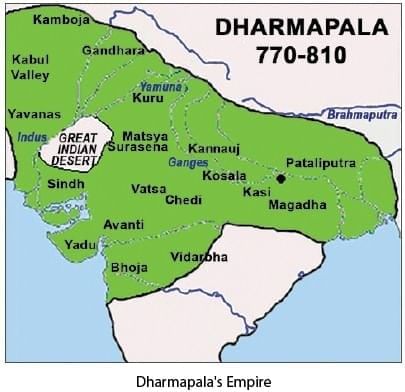
- Devapala (815-855 A.D.
(a) Devapala is the son of Dharmapala who succeeded his father.
(b) He kept the Pala territories intact.
(c) His conquests included the regions of Assam and Orissa, further solidifying the Pala Empire's influence in Eastern India. - Mahipala (998-1038 A.D.)
(a) The Palas became powerful during his reign.
(b) The Pala dynasty declined after the death of Mahipala. - Govinda Pala: Govinda Pala is noted as the last king of the Pala dynasty, representing the final chapter of a once-mighty empire that played a crucial role in the history of Northern and Eastern India.
2. Dominance in Eastern India: Palas ruled eastern India for about a century (mid-8th to mid-9th century), extending to Varanasi.
3. Military Strength: Arab merchant Sulaiman noted a large Pala army, possibly with 50,000 elephants (numbers may be exaggerated), though it’s unclear if it was a standing army or feudal levies.
4. Cultural Contributions:
- Supported Buddhism, reviving Nalanda University and founding Vikramasila University, and built viharas for monks.
- Fostered ties with Tibet, sending scholars like Santarakshita and Dipankara, attracting Tibetan students.
- Also patronized Saivism and Vaishnavism, granting land to Brahmans to boost agriculture in Bengal.
5. Trade and Prosperity: Prosperous trade with Southeast Asia (Burma, Malaya, Java, Sumatra) brought gold and silver; the Buddhist Sailendra dynasty built a monastery at Nalanda with Devapala’s support, reflecting strong ties.
Pratiharas
The Pratiharas were also called as Gurjara. They ruled between 8th and 11th century A.D. over I northern and western India. Pratiharas: A fortification-The Pratiharas stood as a fortification of India's defence against the hostility of the Muslims from the days of Junaid of Sind (725.A.D.) to Mahmud of Ghazni.
1. Rulers:
- Nagabhatta I (725-740 A.D.)
(a) Founder of the Pratihara dynasty with Kanauj as it's capital.
(b) He established the foundation for the dynasty's rule in northern and western India. - Vatsaraja and Nagabhatta II
(a) Played a vital role in merging the empire. - Mihirabhoja
(a) The most powerful Pratihara king.
(b) During his period, the empire expanded from Kashmir to Narmada and from I Kathiawar to Bihar.
(c) Was a devotee of Vishnu and took the title "Adivaraha". - Mahendrapala (885-908 A.D.)
(a) Son of Mihirabhoja, was also a powerful ruler.
(b) He extended his control over Magadha and North Bengal.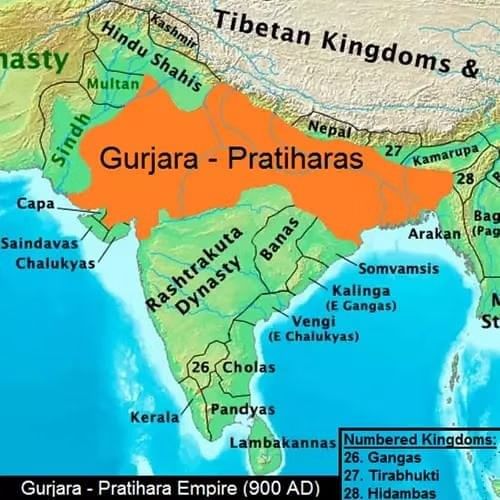
2. Dominance and Culture:
- The Pratiharas ruled north India for over a century (early 9th to mid-10th century), with Al-Masudi describing their vast empire (1,80,000 villages, 2000 km by 2000 km) and powerful army of 7-9 million men across four divisions, excelling in cavalry despite having only 2000 war elephants.
- Patronized learning and literature, hosting Sanskrit poet Rajashekhar at Mahipala’s court and enhancing Kanauj with buildings and temples.
- Despite hostility to Arab rulers of Sind, facilitated scholar and trade exchanges with West Asia, introducing Indian sciences like mathematics and medicine.
3. Decline of the Pratiharas
(a) Rajyapala was the last Pratihara king.
(b) Vast empire was reduced to Kanauj.
(c) The Pratihara power began to decline after Mahmud of Ghazni attacked the I kingdom in 1018 A.D.
(d) After the decline of the Prathiharas their feudatories Palas, Tomars, Chauhans, Rathors, Chandellas.
(e) Guhilas and Paramaras became independent rulers.
(f) There was complete anarchism in Bengal between 750-760 A.D.
4. Pratiharas were patrons of learning - Great poet Rajashekhar lived at court of Mahipala. Bhoja's grandson. Al-Masudi visited Gujarat from Baghdad in 915 and tells about Pratihara kingdom.
Rashtrakutas
The Rashtrakutas were a remarkable dynasty that ruled the Deccan while the Palas and Pratiharas dominated northern India. Founded by Dantidurga, who established the capital at Manyakhet (Malkhed) near modern Sholapur, they controlled northern Maharashtra and engaged in conflicts with the Pratiharas over Gujarat and Malwa, and with the eastern Chalukyas, Pallavas, and Pandyas. Their rule lasted nearly 200 years until the 10th century.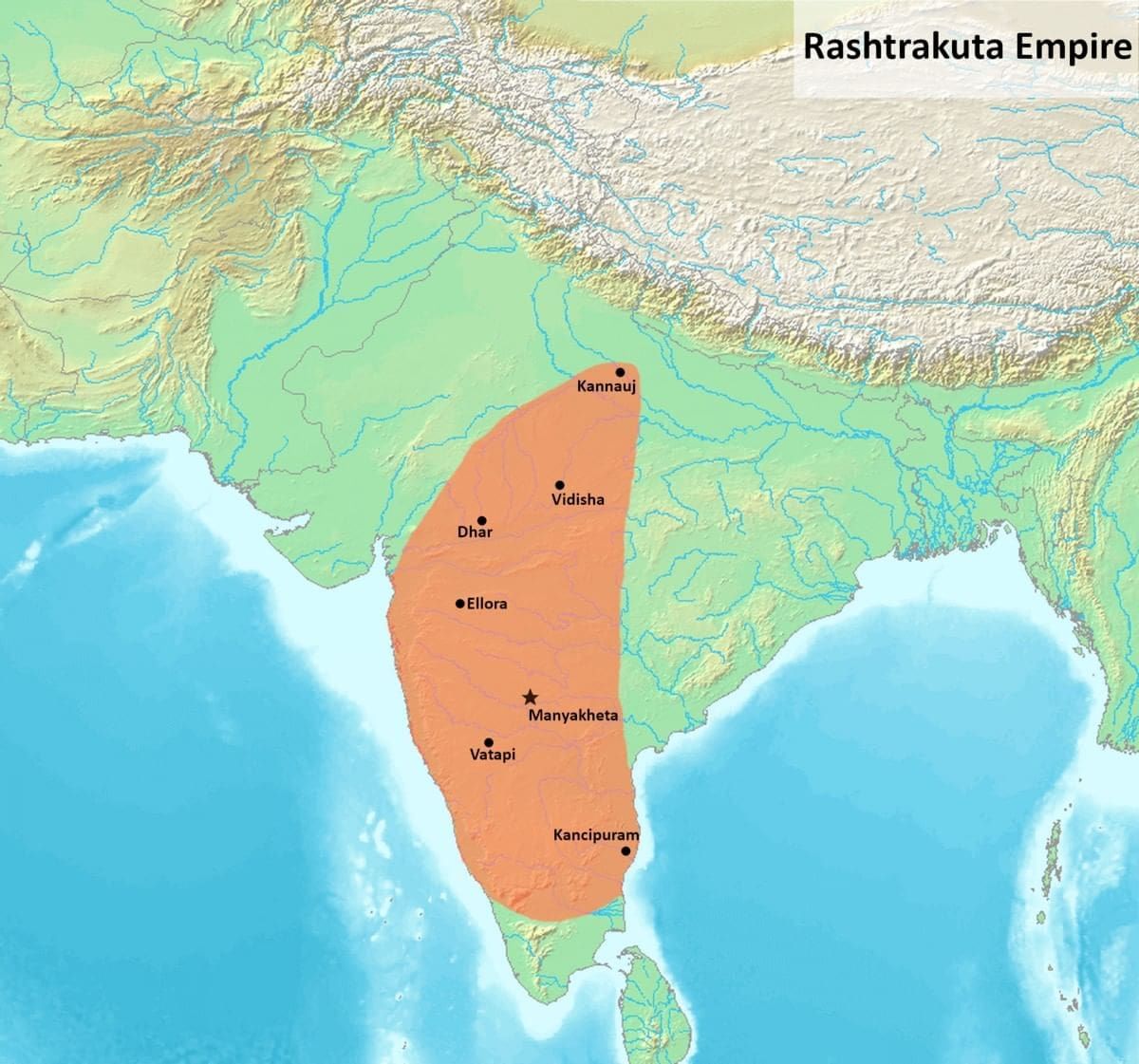
1. Rulers of Rashtakutas Dynasty:
(i) Dantidurga: Founded the kingdom with capital at Malkhed (near Solapur). Dominated northern Maharashtra.
(ii) Govinda III annexed Kanauj, Malwa and turned South and defeated Lankan rulers.
(iii) Amoghvarsha: preferred pursuit of literature and religion than that of war. Wrote first Kannada book on poetics. Faced many rebellions in far-flung areas of empire. Empire weakened hereafter.
(iv) Indra III: amoghvarsha's grandson (915-927) re-established it. Fie was the most powerful ruler after death of Mahipala and sacking of Kanauj.
(v) Balhara or Vallabhraja: Al-Masudi says he was the greatest king of India and most Indian rulers accepted his suzerainty.
(v) Krishna III (934-963) was the last ruler.
2. Cultural and Religious Tolerance:
- Rashtrakutas patronized Shaivism, Vaishnavism and Jainism. Rock-cut Shiva temple at Ellora = Rashtrakuta king Krishna I.
- Allowed Muslim traders to settle, build mosques, and preach, boosting foreign trade.
3. Art and Literature:
- They were great patrons of arts and literature.
- Supported Sanskrit, Prakrit, and apabhramsha poets like Svayambhu, enriching the cultural landscape.
Political Ideas and Organization
Administrative system was based on Gupta empire, Harsha's kingdom in the north and Chalukyas in the Deccan.
Administrative System
- King = head administrator and commander-in-chief of armed forces. Usually the eldest son succeeded, younger sons were made provincial governors, brothers fought to gain throne. Princesses were rarely appointed, but Chandrobalabbe, Amoghvarsha I's daughter, administered Raichur doab for some time.
- Kings were aided by ministers, who were also hereditary. There were ministers for foreign affairs, revenue, treasurer, armed forces chief, chief justice and purohit. More than one post could be combined. There were also officials of the household (antahpur).
- Court was a centre of dispensing justice, policy making and cultural events. King's position was hereditary. Wars were frequent.
- Bearing arms for self-protection was the right of an individual, according to writer Medhatithi.
- Territories were:
(a) Directly administered and
(b) Ruled by vassals.
Territorial Divisions
Palas and Pratiharas
- Bhukti (province) under Uparika (governor)
- Mandala / Visaya (district) under Visayapati (head)
- Pattala (unit for realization of land revenue and law and order)
Bhukti > Visaya > Pattala
Rashtrakuta Empire
- Rashtra (province) under Rashtrapati
- Visaya (dist) under Visayapati
- Bhukti (unit for realization of land revenue and law and order)
Rashtra > Visaya > Bhukti

Village Administration
- VILLAGE was placed below these administrative units. Its administration was carried out by village headman whose posts were hereditary. They were paid by rent-free land grants.
- Headman was helped by village elders = gram-mahajan OR gram-Mahattara.
- Law and order responsibility = koshta-pala = kotwal
- Hereditary revenue officers in Deccan = nad-gavundas or desa-gramakutas.
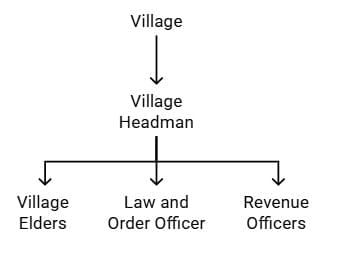
- State was essentially secular. Kings were worshippers of Shiva, Vishnu, Jainism and Buddhism but they never I persecuted non-followers and patronized all religions equally.
State and Religion
- Secular Nature: Kings followed Shiva, Vishnu, Buddhism, or Jainism but patronized all faiths equally, avoiding persecution. Rashtrakuta kings welcomed Muslims, allowing mosques and preaching.
- Duties and Limits: Kings protected Brahmans and upheld the four varnas as per Dharmashastras, guided by the purohit, though the purohit didn’t dominate. Medhatithi noted royal authority stemmed from Dharmashastras and Arthashastra, keeping politics and religion separate, with rajadharma based on political principles.
- Religious Role: Religion legitimized rule, leading kings to build grand temples and grant land to Brahmans for maintenance.
Armed Forces
Composition: Empires maintained large infantry, cavalry, and war-elephants, with Palas having the most elephants. Pratiharas and Rashtrakutas imported horses from Arabia, West Asia, Khurasan, and Central Asia, boasting the finest cavalry. War-chariots were obsolete.
Organization: Rashtrakutas had numerous forts with independent commanders. Infantry included regular, irregular, and vassal levies, with Palas recruiting from Malwa, Assam, south Gujarat, and Karnataka. Palas and possibly Rashtrakutas had navies, though details are scarce.
Vassal Relationships
Structure: Empires included directly administered areas and vassal-ruled territories, where chiefs were autonomous internally but owed loyalty, tribute, and troops. Vassal sons might attend the overlord to prevent rebellion, and marriages with the overlord’s family were common.
Conflicts: Vassals often sought independence, leading to frequent wars, e.g., Rashtrakutas vs. Vengi and Karnataka chiefs, Pratiharas vs. Paramaras and Chandellas.
|
210 videos|853 docs|219 tests
|
FAQs on Old NCERT Summary (Satish Chandra): Northern India - History for UPSC CSE
| 1. What is the significance of the Old NCERT book by Satish Chandra in understanding the history of Northern India? |  |
| 2. What is the difference between the Old NCERT book by Satish Chandra and the newer versions available in the market? |  |
| 3. How can the Old NCERT book by Satish Chandra be useful for exam preparation? |  |
| 4. Are there any limitations or drawbacks of relying solely on the Old NCERT book by Satish Chandra for studying Northern India's history? |  |
| 5. Can the Old NCERT book by Satish Chandra be helpful for non-academic readers interested in Northern India's history? |  |
















